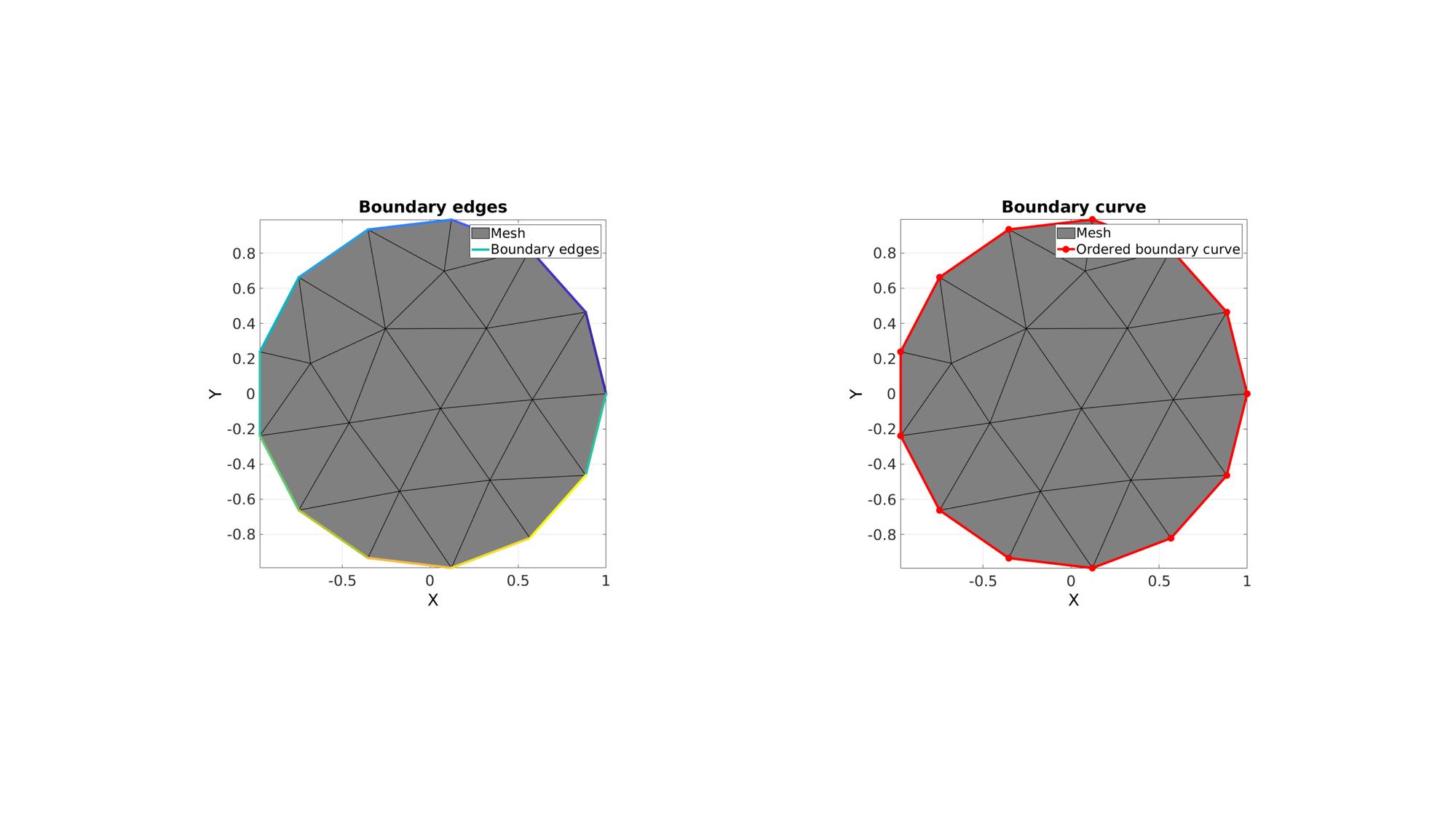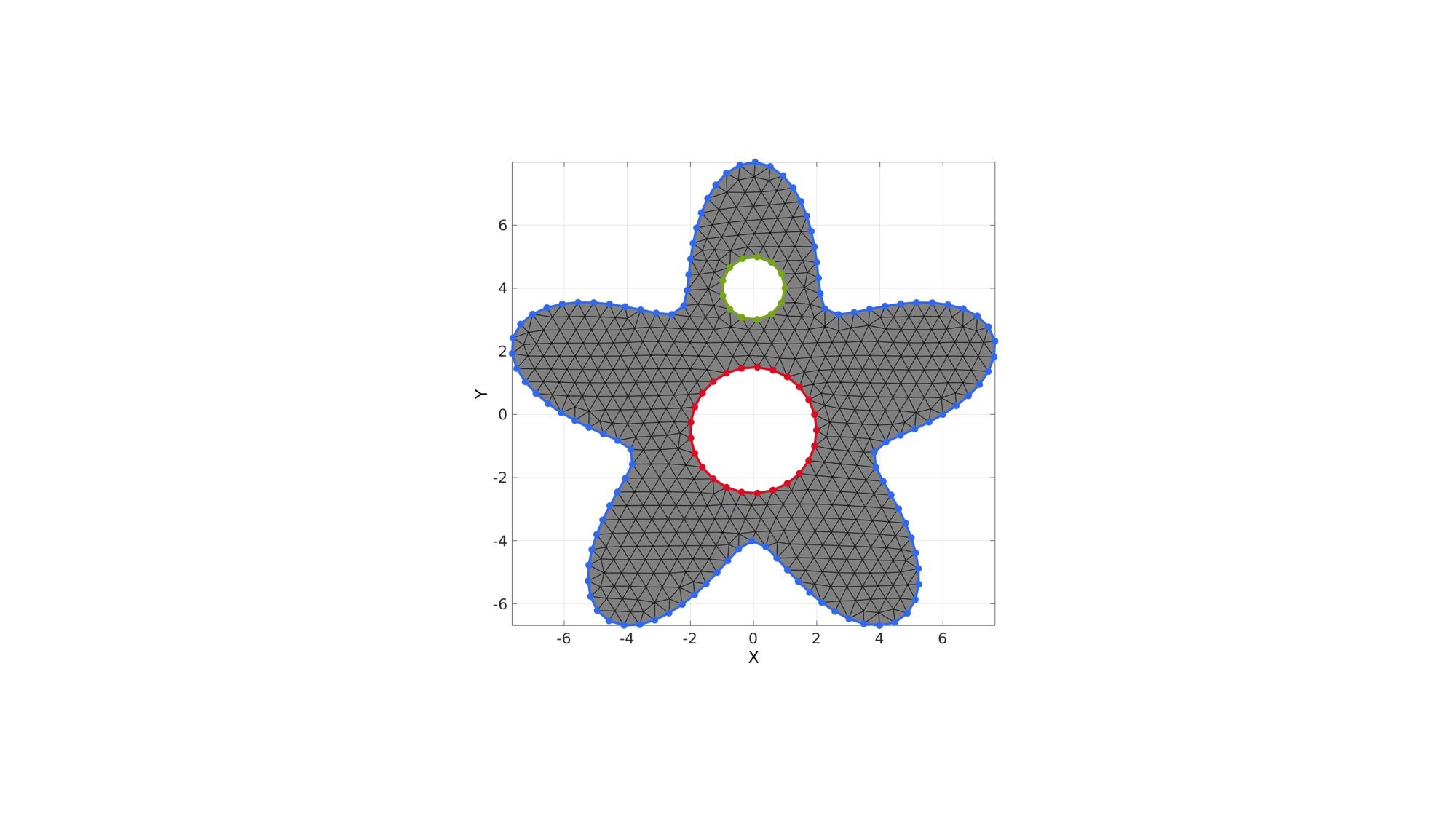edgeListToCurve
Below is a demonstration of the features of the edgeListToCurve function
Contents
clear; close all; clc;
Syntax
[indList]=edgeListToCurve(E);
Description
This function converts the nx2 edges array E, which should define a single curve, to an ordered list of mx1 indices indList for that curve. Note that iff the edges define a closed curve the first and last indices in the ordered list are the same and therefore repeated.
Examples
Plot settings
markerSize=40; lineWidth=4; fontSize=25;
Getting indices for a single boundary curve
Creating example geometry
t=linspace(0,2*pi,50); t=t(1:end-1); %Angles V1=[cos(t(:)) sin(t(:))]; %Desired point spacing pointSpacing=0.5; [F,V]=regionTriMesh2D({V1},pointSpacing,1,0);
Get boundary edges
Eb=patchBoundary(F,V);
Use edgeListToCurve to get curve indices
indList=edgeListToCurve(Eb);
Visualize example mesh and boundary edges/curves
cFigure; subplot(1,2,1); hold on; title('Boundary edges','FontSize',fontSize) hp1=gpatch(F,V,'kw','k',1,1); hp2=gpatch(Eb,V,'none',(1:1:size(Eb,1))',1,lineWidth); legend([hp1 hp2],{'Mesh','Boundary edges'}); axisGeom(gca,fontSize); view(2); subplot(1,2,2); hold on; title('Boundary curve','FontSize',fontSize) hp1=gpatch(F,V,'kw','k',1,1); hp2=plotV(V(indList,:),'r.-','MarkerSize',markerSize,'LineWidth',lineWidth); legend([hp1 hp2],{'Mesh','Ordered boundary curve'}); axisGeom(gca,fontSize); view(2); drawnow;

Getting indices for a multiple boundary curves
Creating example geometry with multiple boundary sets
%Boundary 1 ns=150; t=linspace(0,2*pi,ns); t=t(1:end-1); r=6+2.*sin(5*t); [x,y] = pol2cart(t,r); V1=[x(:) y(:)]; %Boundary 2 [x,y] = pol2cart(t,ones(size(t))); V2=[x(:) y(:)+4]; %Boundary 3 [x,y] = pol2cart(t,2*ones(size(t))); V3=[x(:) y(:)-0.5]; %Defining a region regionCell={V1,V2,V3}; %A region between V1 and V2 (V2 forms a hole inside V1) plotOn=1; %This turns on/off plotting %Desired point spacing pointSpacing=0.5; [F,V]=regionTriMesh2D(regionCell,pointSpacing,1,0);
Get boundary edges
Eb=patchBoundary(F,V);
Use grouping to "seperate" boundary sets
optionStruct.outputType='label';
G=tesgroup(Eb,optionStruct);
cFigure; hold on; gpatch(F,V,'kw','k',1,1); axisGeom(gca,fontSize); view(2); plotColors=gjet(max(G(:))); for q=1:1:max(G(:)) E_now=Eb(G==q,:); plotV(V(E_now,:),'b.','markersize',25); [indListNow]=edgeListToCurve(E_now); hp=plotV(V(indListNow,:),'b.-','MarkerSize',markerSize,'LineWidth',lineWidth); hp.Color=plotColors(q,:); end drawnow;


GIBBON www.gibboncode.org
Kevin Mattheus Moerman, [email protected]
GIBBON footer text
License: https://github.com/gibbonCode/GIBBON/blob/master/LICENSE
GIBBON: The Geometry and Image-based Bioengineering add-On. A toolbox for image segmentation, image-based modeling, meshing, and finite element analysis.
Copyright (C) 2019 Kevin Mattheus Moerman
This program is free software: you can redistribute it and/or modify it under the terms of the GNU General Public License as published by the Free Software Foundation, either version 3 of the License, or (at your option) any later version.
This program is distributed in the hope that it will be useful, but WITHOUT ANY WARRANTY; without even the implied warranty of MERCHANTABILITY or FITNESS FOR A PARTICULAR PURPOSE. See the GNU General Public License for more details.
You should have received a copy of the GNU General Public License along with this program. If not, see http://www.gnu.org/licenses/.